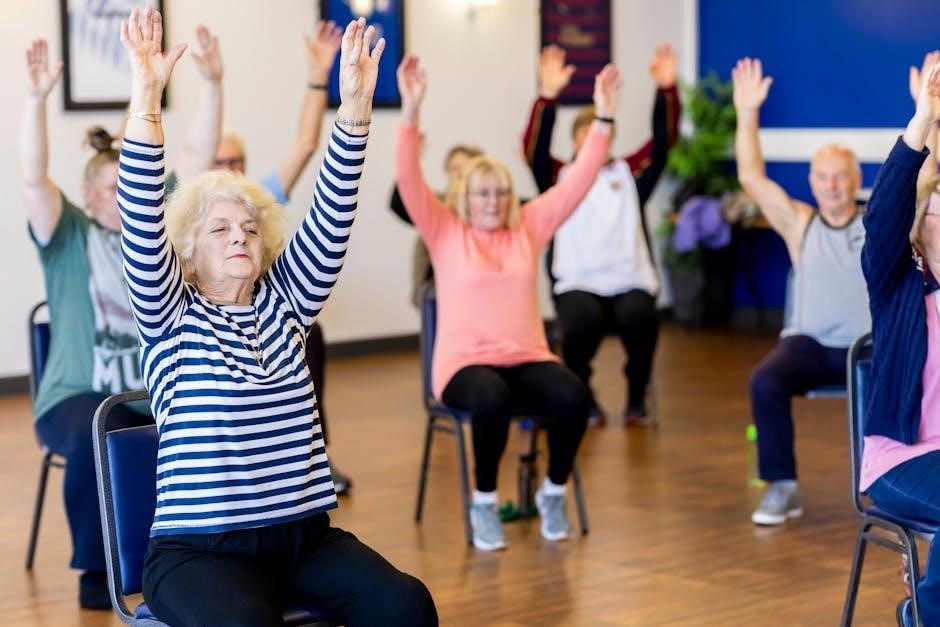Thoracic mobility exercises target the upper back‚ enhancing spinal flexibility and posture. They reduce stiffness‚ improve breathing‚ and prevent injuries‚ essential for overall spinal health and movement efficiency.
Overview of Thoracic Mobility
Thoracic mobility refers to the movement and flexibility of the thoracic spine‚ the upper back region. It plays a crucial role in posture‚ breathing‚ and overall spinal health. Limited thoracic mobility can lead to stiffness‚ poor posture‚ and even discomfort in the neck and lower back. Exercises targeting this area focus on improving rotation‚ extension‚ and lateral flexion. Techniques include spinal rotations‚ cat-cow stretches‚ and foam rolling. Enhancing thoracic mobility promotes better movement patterns‚ reduces injury risk‚ and improves athletic performance. Regular practice is essential for maintaining a healthy‚ flexible spine.
Importance of Thoracic Spine Health
The thoracic spine‚ located in the upper back‚ is vital for posture‚ movement‚ and respiratory function. Poor thoracic mobility can lead to stiffness‚ back pain‚ and limited range of motion. Maintaining healthy thoracic mobility is essential for preventing injuries‚ enhancing athletic performance‚ and improving overall spinal alignment. A flexible thoracic spine supports proper breathing mechanics and reduces strain on the neck and lower back. Neglecting thoracic health can result in chronic discomfort and poor posture‚ emphasizing the need for regular exercises to maintain optimal spinal function and overall well-being.
Common Issues Related to Thoracic Mobility
Common issues related to thoracic mobility include rounded shoulders‚ upper back stiffness‚ and limited range of motion. Prolonged sitting or poor posture can lead to a hunched thoracic spine‚ causing discomfort and restricted movement. This can also result in muscle imbalances‚ where some muscles become overactive while others are underactive. Poor thoracic mobility is often linked to neck pain‚ headaches‚ and difficulty breathing. Additionally‚ it can increase the risk of injury during physical activities. Addressing these issues through targeted exercises can significantly improve overall spinal function and reduce the likelihood of chronic pain or discomfort.
Types of Thoracic Mobility Exercises
Thoracic mobility exercises include rotations‚ twists‚ and stretches to enhance flexibility and improve posture. These movements target the upper back‚ promoting better spinal movement and overall alignment.
Thoracic Spine Rotations
Thoracic spine rotations are essential for improving mobility in the upper back. They involve twisting the torso while keeping the hips and legs stable‚ enhancing flexibility and reducing stiffness. These exercises can be performed seated or standing‚ often with hands placed on the shoulders or hips for support. Proper breathing is crucial‚ as exhaling during the twist helps deepen the movement. Regular practice can improve posture‚ reduce tension‚ and enhance overall spinal health. Variations include dynamic rotations for active mobility and passive stretches for deeper release‚ catering to different fitness levels and goals. Consistency is key for lasting benefits.
Cat-Cow Stretch
The Cat-Cow stretch is a gentle‚ dynamic exercise that promotes thoracic mobility by alternating between spinal flexion and extension. Performed on all fours‚ it involves arching the back (Cow pose) and rounding it (Cat pose). This movement helps loosen tight muscles‚ improve spinal flexibility‚ and enhance spinal awareness. It is an excellent warm-up or cool-down exercise‚ suitable for all fitness levels. Regular practice can reduce stiffness‚ improve posture‚ and prepare the thoracic spine for more intense movements. Consistency is key to experiencing its full benefits‚ making it a foundational exercise in thoracic mobility routines.
Seated Thoracic Twist
The Seated Thoracic Twist is an effective exercise for improving spinal rotation and thoracic mobility. Sit tall with feet on the floor‚ knees bent‚ and hands behind your head. Gently twist your torso to one side‚ keeping hips facing forward‚ and hold for a breath. Alternate sides slowly‚ focusing on controlled movement. This exercise enhances spinal flexibility‚ reduces muscle tension‚ and improves posture. It is particularly beneficial for individuals with sedentary lifestyles or those experiencing upper back stiffness. Consistent practice can lead to better range of motion and reduced discomfort in the thoracic region.
Side-Bending Exercises
Side-bending exercises target the lateral movement of the thoracic spine‚ improving flexibility and reducing stiffness. Stand or sit tall‚ arms extended overhead. Slowly bend to one side‚ sliding one hand down your leg while keeping the other overhead. Hold briefly‚ then return to the starting position and repeat on the opposite side. Focus on smooth‚ controlled movements to avoid strain. These exercises enhance spinal mobility‚ improve posture‚ and can alleviate tension in the upper back. Regular practice promotes better alignment and reduces the risk of thoracic-related discomfort‚ making them a valuable addition to any mobility routine.
Foam Rolling Techniques
Foam rolling is a self-myofascial release method that enhances thoracic mobility by relieving muscle tightness and improving spinal movement. Using a large foam roller‚ lie on your back and place the roller under your upper back. Slowly roll up and down‚ applying moderate pressure to release tension. Focus on areas that feel stiff or restricted‚ pausing for a few breaths to allow relaxation. For deeper release‚ try side-lying or using a smaller roller for targeted areas. Regular foam rolling can improve spinal flexibility‚ reduce muscle soreness‚ and complement other thoracic exercises for better overall mobility and posture.

Benefits of Thoracic Mobility Exercises
Thoracic mobility exercises enhance spinal flexibility‚ improve posture‚ and reduce upper back stiffness. They also boost breathing efficiency‚ alleviate back pain‚ and improve overall athletic performance and movement.
Improved Posture
Thoracic mobility exercises significantly enhance posture by reducing slouching and hunched shoulders. They strengthen the muscles between the shoulders and improve spinal alignment‚ promoting a more upright and balanced position. Regular practice helps maintain proper curvature of the upper back‚ preventing chronic pain and discomfort. Improved thoracic mobility also enhances body awareness‚ encouraging better sitting and standing habits. Over time‚ consistent exercise fosters a more confident and healthy posture‚ reducing the risk of long-term spinal issues and improving overall physical alignment and efficiency in daily activities.

Enhanced Breathing
Thoracic mobility exercises play a crucial role in improving breathing mechanics by enhancing the movement of the rib cage and thoracic spine. Increased spinal flexibility allows for greater expansion of the lungs‚ leading to deeper‚ more efficient breaths; This can boost oxygen intake and overall respiratory function. Improved thoracic mobility also reduces respiratory muscle strain‚ making breathing feel more natural and effortless. Regular practice is particularly beneficial for athletes seeking enhanced performance and individuals with respiratory conditions‚ as it promotes better lung capacity and reduces stress on the breathing muscles‚ fostering a healthier respiratory system.
Reduced Back Pain
Thoracic mobility exercises are highly effective in reducing back pain by addressing stiffness and poor movement patterns in the upper spine. Improved mobility in the thoracic region alleviates strain on the lower back and neck‚ common areas for discomfort. When the thoracic spine is rigid‚ it can lead to muscle imbalances and altered movement mechanics‚ exacerbating back pain. Regular practice of these exercises helps restore natural spinal motion‚ reducing tension and discomfort. Strengthening the muscles around the thoracic spine further enhances stability‚ providing long-term relief and preventing future episodes of back pain through consistent and targeted practice.
Improved Athletic Performance
Thoracic mobility exercises significantly enhance athletic performance by improving flexibility‚ range of motion‚ and rotational movements. Better spinal movement allows athletes to generate more power and speed‚ particularly in sports involving twisting or overhead actions. Enhanced core stability and reduced muscle tightness also contribute to improved coordination and endurance. By optimizing thoracic mobility‚ athletes can perform at higher levels‚ reduce the risk of injury‚ and maintain peak physical condition. This makes thoracic mobility a cornerstone of training for athletes seeking to maximize their performance and achieve their goals effectively.

Creating a Thoracic Mobility Routine
Start with a thorough assessment to identify mobility limitations. Set clear goals‚ incorporate exercises‚ and gradually progress intensity. Consistency is key for lasting results and improved spinal function.
How to Start
Begin by consulting a healthcare professional or physical therapist to assess your current thoracic mobility. Start with a basic routine‚ incorporating exercises like cat-cow stretches and thoracic rotations. Use tools such as foam rollers to enhance flexibility. Focus on proper breathing techniques to maximize the effectiveness of each movement. Gradually increase intensity and duration as comfort and mobility improve. Consistency is key‚ so aim to practice 3-4 times per week. Track progress to ensure exercises are challenging yet safe‚ promoting long-term spinal health and overall well-being. Proper form and technique are essential to avoid injury and achieve optimal results.
Frequency and Duration
Aim to practice thoracic mobility exercises 3-4 times per week for optimal results. Start with 10-15 minute sessions and gradually increase as your body adapts. Consistency is crucial for improving flexibility and reducing stiffness. Listen to your body and rest when needed to avoid overexertion. Incorporate dynamic warm-ups before each session to prepare your muscles. Focus on controlled movements and deep breathing to enhance the effectiveness of each exercise. Over time‚ you can extend the duration or intensity‚ ensuring progressive improvement in thoracic mobility and overall spinal health. Regular practice will help maintain flexibility and prevent future discomfort.
Progression of Exercises
Progressing thoracic mobility exercises involves gradually increasing intensity and complexity. Begin with gentle stretches like cat-cow or seated twists‚ ensuring proper form. As flexibility improves‚ introduce dynamic movements such as thoracic rotations with resistance bands or light weights. Advanced techniques include weighted exercises or partner-assisted stretches to deepen the range of motion. Always prioritize control and breathing to maximize benefits and minimize injury risk. Adjustments should be incremental‚ allowing the body to adapt without strain. Tailor progressions to individual goals‚ whether for improved posture‚ athletic performance‚ or chronic pain management. Consistent‚ safe progression enhances long-term spinal health and mobility.

Advanced Thoracic Mobility Techniques
Advanced thoracic mobility techniques involve integrating resistance tools and dynamic movements to enhance spinal flexibility and strength‚ promoting superior posture and functional movement patterns naturally.
Weighted Exercises
Weighted thoracic exercises incorporate resistance to strengthen muscles and improve spinal mobility. Using light dumbbells or resistance bands‚ these exercises target the upper back‚ enhancing flexibility and posture. Techniques like weighted thoracic rotations or extensions can be performed while seated or standing‚ promoting controlled movement. They help build stability and reduce stiffness‚ making them ideal for advanced practitioners seeking to deepen their mobility practice. Proper form is crucial to avoid injury‚ so starting with lighter weights and gradually increasing resistance is recommended. These exercises are particularly beneficial for improving functional strength and reducing the risk of thoracic-related injuries.
Dynamic Stretching
Dynamic stretching involves active‚ movement-based stretches that improve thoracic mobility by increasing blood flow and reducing stiffness. Examples include arm circles‚ side bends‚ and thoracic rotations performed with controlled‚ flowing motions. These exercises are particularly effective for enhancing flexibility and preparing the spine for physical activity. By incorporating dynamic stretches‚ individuals can improve their range of motion and reduce the risk of injury. They are versatile and can be modified to suit different fitness levels‚ making them a valuable addition to any thoracic mobility routine. Regular practice fosters better spinal movement and overall athletic performance.
Partner-Assisted Stretching

Partner-assisted stretching involves a second person helping to deepen stretches‚ enhancing thoracic mobility. A partner can apply gentle‚ controlled pressure to increase the stretch’s effectiveness. This method allows for targeted focus on specific areas of the thoracic spine‚ improving flexibility and range of motion. Exercises like the thoracic rotation stretch can be performed with a partner’s guidance‚ ensuring proper alignment and maximizing benefits. Regular practice with a partner can enhance spinal movement‚ reduce muscle tension‚ and improve overall posture. Clear communication is key to ensure comfort and safety during these stretches.
Thoracic mobility exercises are essential for maintaining spinal health and improving overall well-being. Regular practice enhances posture‚ breathing‚ and reduces pain‚ promoting a stronger‚ more flexible upper back.
Final Thoughts on Thoracic Mobility
Thoracic mobility exercises are a cornerstone of spinal health‚ offering numerous benefits for posture‚ breathing‚ and overall physical function. Consistent practice can significantly reduce stiffness‚ enhance athletic performance‚ and prevent injuries. Incorporating these exercises into your daily routine ensures long-term spinal well-being and improved movement efficiency. Remember‚ maintaining thoracic mobility is an investment in your body’s flexibility and strength‚ fostering a healthier‚ more active lifestyle. Stay consistent and experience the transformative power of thoracic mobility for yourself.
Encouragement to Practice Regularly
Consistency is key to reaping the rewards of thoracic mobility exercises. Even a few minutes daily can lead to noticeable improvements in posture‚ breathing‚ and overall spinal health. Start with simple stretches and gradually incorporate more advanced techniques as your flexibility and strength increase. The benefits of regular practice extend beyond physical health‚ boosting mental well-being by reducing stress and enhancing mobility. Make thoracic exercises a priority and enjoy the long-term advantages of a healthier‚ more agile spine. Your body will thank you for the dedication and care.